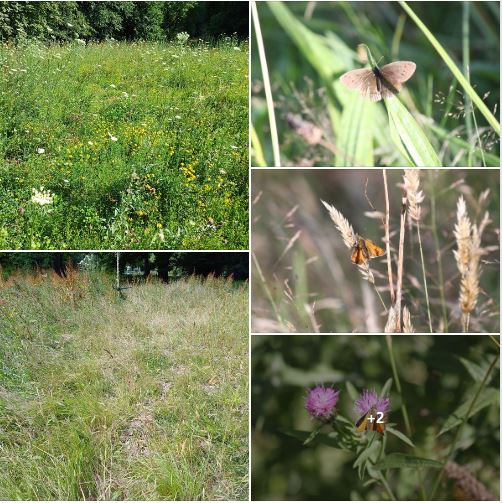“Rewilding is one of those words that prompts debate, some of it less than polite: I just say it usually the wrong word.” [Ed Dolpin, Sid Valley Biodiversity Group]
.
There is quite a debate as to exactly what we mean by ‘rewilding’.
The debate continues in a very healthy and helpful way, as per usual, on the social media pages of the SVBG – here conducted between steering group member Ed Dolphin and student Josh Parker from the last couple of days:
Another tale of two butterfly counts.
Ed: In the Knowle there is the area sown with ‘wild flower’ seed mix, actually mostly cultivated or overseas varieties for example Wild Carrot that is four times the height of the native plants on the cliff. It looks wonderful to humans but the local insects do not recognise the flowers as food sources. 15 minute butterfly count, 2 large whites.
In the park there is the area that has been neglected by EDDC for quite a while and the ‘weeds’ have taken over. It looks scruffy to humans but insects see it as a buffet. 15 minute butterfly count, 10 Ringlets, 4 Meadow Browns, 3 Skippers, 2 large 1 small, 2 Commas and 1 Red Admiral.

Josh: This sort of thing is exactly why I’m now training up in rewilding instead of conservation. I’ve seen too many examples of conservation turning into a futile exercise in maintaining the look of a place over all else.
Ed: Rewilding is one of those words that prompts debate, some of it less than polite, I just say it usually the wrong word. The EDDC’s new term renaturing doesn’t thrill me either. The grassland butterflies, and the other grassland biodiversity with less celebrity, do not need a wild environment. They have evolved in managed meadows and pastures. Letting a place go wild does little for them in the long term. What is needed is the restoration of the traditional grassland management. The Knowle was once a pasture but we can’t reinstate Mr Fish’s buffalo.
The best thing to do would be to run it as a meadow. Very early cut and clear, then let it grow until a late cut and clear in late August or early September. This is in the plan that the town council were happy with two years ago, it is just a pity that they haven’t been able to get control of the site because of the ill conceived flood alleviation scheme which has been dogged with design problems that were pointed out at the outset.
Josh: There’s no other word that I’ve come across that covers all the things covered by rewilding. I almost wish there was another word due to all the controversy attached to it. We talk a lot about humans being able to be a keystone species by going things like creating and maintaining meadows. Like you say it’s not possible to reintroduce grazers everywhere to create a mosaic of habitats, so it’s down to us to be the drivers of positive change.
Ed: Going back to traditional farming practices is the best term, hopefully most people can cope with that. Rewilding would see southern England covered in patchy woodland.
Josh: If the glades between and amongst the woodland were made up of varied non-wooded habitats, then could there be a more optimal landscape for biodiversity in Southern England?
Ed: Most people have been sold the meadow as the ideal but it is just one habitat. Woodland glades are also important, probably the only land habitat that would be truly wild, but they require very large herbivores. Coppice mimics the living conditions although by accident rather than design originally. Coppice is labour intensive which is why it is in serious decline. Also it is messy in years 1-3 of regrowth and many people don’t appreciate it.
Meanwhile, down Glen Goyle and into Wales…
Also locally, the local Glen Goyle project is not so much about ‘rewilding’ as ‘managing for nature’, as a town council environment committee member has suggested – with ‘wildscaping’ as another idea.
To go beyond the Valley, the word ‘rewilding’ is clearly very fraught in the likes of Wales – and so farmers will clearly have to be very much included in the debate, says the New Scientist on the Welsh sheep farming hills.
Perhaps ‘regenerative’ farming is a way ahead; reinstating traditional meadows could also help, as shown by the number of ‘coronation meadows’ created; all of which suggests, then, that we need to return, as far as possible, to ‘traditional farming practices’, to help ‘breathe life back into our landscapes’.